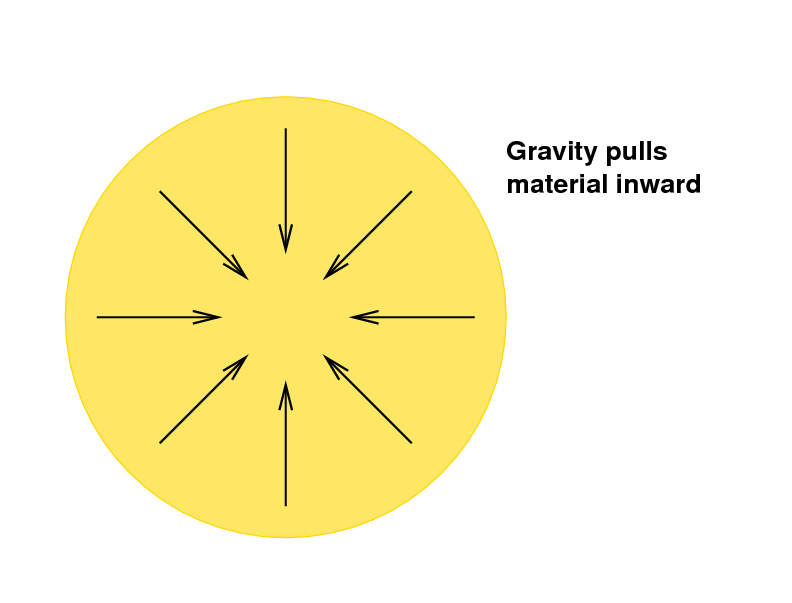
 Copyright © Michael Richmond.
This work is licensed under a Creative Commons License.
Copyright © Michael Richmond.
This work is licensed under a Creative Commons License.
You can find this talk at
http://spiff.rit.edu/richmond/asras/sn_bh/sn_bh.html
I was asked to give a talk about supernovae and black holes, and so I started to think about the way I might give the talk.
"Supernovae are stars which explode," I imagined myself saying. "Why do they explode? Well, there are a couple of different possibilities involving blah blah blah ..." As I thought about the way I would introduce the mechanisms by which a star blows itself apart, I realized I would have to spend some time explaining why this was DIFFERENT from the usual situation; that is, something obviously has to change, in some drastic manner, to cause a star to explode --- but, in order to understand that change, it's really necessary to have a pretty good idea of the original, ordinary situation, before the change occurs.
"Black holes are regions of space in which the density of material has reached and exceeded a special threshold," I began to write. "Conditions are ripe for them to form at the end of a massive star's life, when blah blah blah ...." Again, I realized that I would have to convey the fact that under ordinary circumstances, stars do NOT turn into black holes, before I could get to the changes which tip the balance.
So, after pondering this for a time, I decided that it might profit us all if I gave a talk in which I focus on the hum-drum, commonplace, even boring main sequence stars: why DON'T they explode, or collapse? If I can make it clear that there are specific conditions which maintain these ordinary stars in their ordinary appearances, it might be easier to see the little changes that can push stars outside their comfort zones and cause them either to blow up, or to collapse.
This one's pretty easy to answer, if we choose to start here. The answer is -- because gravity holds the pieces of the star together.

Each atom in the star attracts every other atom in the star with a force which depends on the masses of the atoms and on the distance between them. Some fellow named Newton came up with an equation which provides a quantitative measure of this attractive force.

That Newton also showed that if a set of atoms are distributed in a spherically symmetric system -- as they are in a star -- then the combined forces of all the atoms in the system add up in a simple way: the net gravitational force on any particular atom always points inward, towards the center of the material.
So, each atom in a star is pulled towards the center of the star by gravitational forces. Under ordinary circumstances, this prevents those atoms from flying outwards into space. Sorry, no star-shattering kaboom.
Okay, so gravity pulls the atoms of a star inward. Very well, then, why don't they all fall together and form a tiny little ultradense ball? The answer to this question is also pretty simple, at least for our purposes: too hot.
The material inside stars acts in most ways like an ordinary gas. Atoms are not bound together tightly, as they are in a solid material, and the chemical forces between adjacent atoms are too weak and too short-lived, in general, to provide even the loose associations of a liquid. Each atom or particle goes its own way, flying through the star until it crashes into another atom, then bouncing off in a new direction.
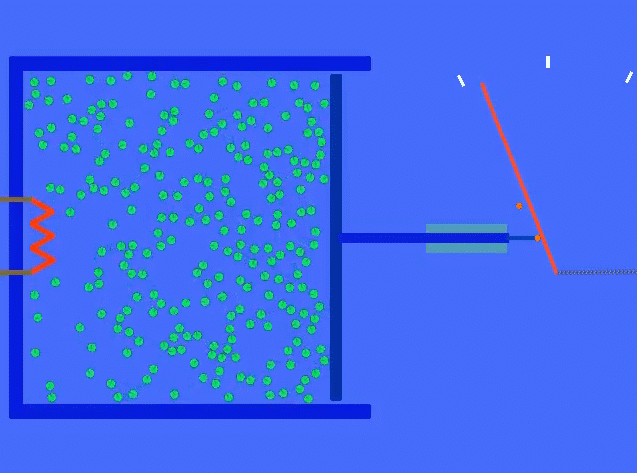
The speed of the particles in a gas depends on their temperature. If the gas is cold, the particles move slowly, and their collisions are relatively gentle; if the gas is hot, on the other hand, the particles fly at high speeds, making their collisions violent.
In a star, the gas is very hot: the temperatures range from a few thousand degrees in the outer regions to many millions of degrees in the central portions. Therefore, the individual gas particles have enormous speeds; for example, near the center of the Sun, where the temperature is very roughly 15 million Kelvin, the nucleus of a hydrogen atom -- a proton -- will move with a typical speed of

When two particles at such high speeds bang into each other, they exert strong forces, pushing each other apart again. It is these collisions which oppose the contraction of a star: as a star shrinks, the individual particles must be moved closer to each other -- but that means that they will collide more frequently, and so push each other apart more often. The net result of the incessant bouncing of thousands and millions and billions of little particles is a pressure that pushes outwards.
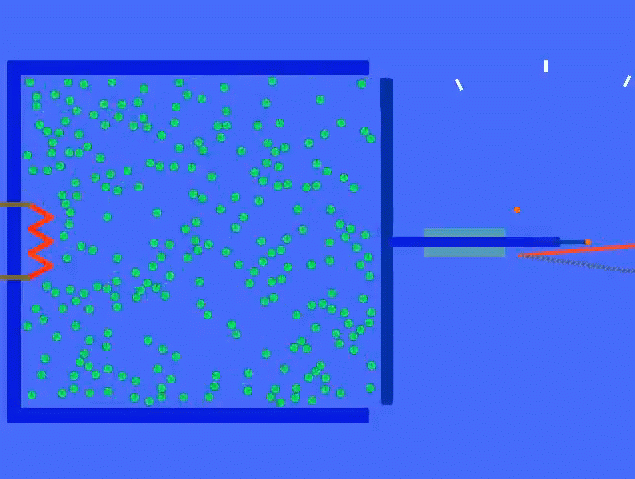
Keep a star hot enough, and the motions of its atoms will create a pressure to counteract the inward pull of gravity.
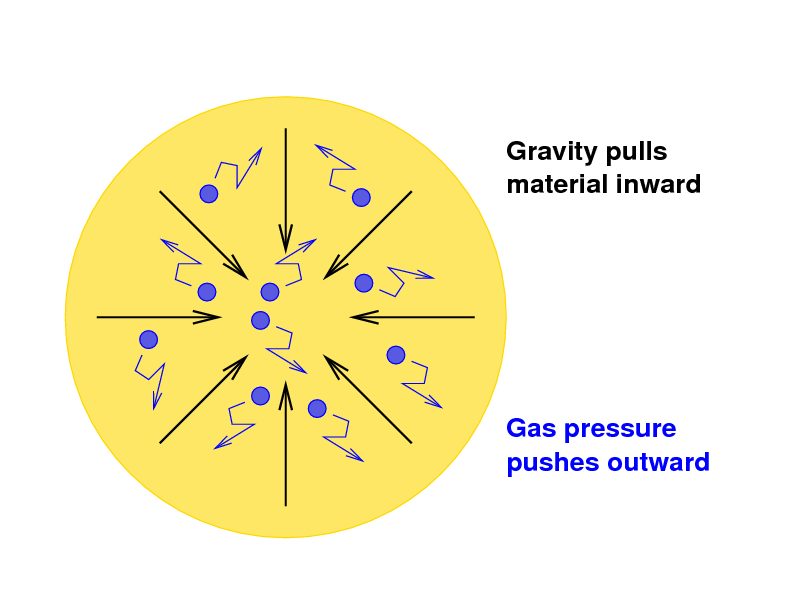
A short digression -- why don't PEOPLE collapse?
"Hey, wait a minute", I hear someone out there saying, "why don't PEOPLE collapse? We don't have temperatures of millions of degrees. And what about ice cubes, and other even colder objects?"
It turns out that there are three ways that matter can resist being compressed. One of them occurs here on Earth, inside people and ice cubes and rocks and all ordinary objects; the other two occur only in special types of stars.
It will be easier to describe these three anti-compression mechanisms if I introduce a few of the most important members of the atomic realm.
The electron, proton, and neutron are the building blocks for people, rocks and stars. Note that electrons and protons have the a charge of the same size (though opposite sign), but very different masses.
- Ordinary atoms consist of a protons and neutrons in a compact core, surrounded by electrons. When two atoms approach each other, the electrons in one atom repel the electrons in the other atom via electric forces.
- If matter is compressed hard enough, the individual atoms disappear, to create a sort of particle soup. In this state, called "degenerate matter", there are very strong repulsive forces due to the close proximity of electrons. This electron degeneracy pressure can prevent the soup from collapsing further ... up to a point.
- If matter is compressed even harder, the electrons and protons merge together to form a neutron soup. In this state, there are very strong repulsive forces due to the close proximity of neutrons (yes, even though they don't have any electric charge). This neutron degeneracy pressure, which is stronger than electron degeneracy pressure, can prevent the soup from collapsing further ... up to a point.
Ordinary stars exhibit a balance between opposing tendencies: the gas pressure which is always pushing outward, and the gravitational force which is always pulling inward. The nuclear reactions at the center of a star run more quickly if the temperature rises, and slow down if the temperature drops. There's a sort of "nuclear thermostat" which, in a very nice manner, keeps ordinary stars at a roughly constant size and temperature. Our own Sun has had a photosphere of (roughly) 5500 Kelvin for over 4 billion years, and will continue to shine at (roughly) this temperature for another 4 or 5 billion years.
But --- what if we tipped the balance? Suppose that we could somehow remove the central heat source of a star? Then the material inside would cool down, the gas pressure would decrease, but the gravitational force would be as large as always. Less outward pressure + same inward force = shrinking!
Now, the degree to which the star shrinks depends on its mass. There are three possibilities:
The result is a white dwarf star, which has the mass of the Sun, but the size of Earth.
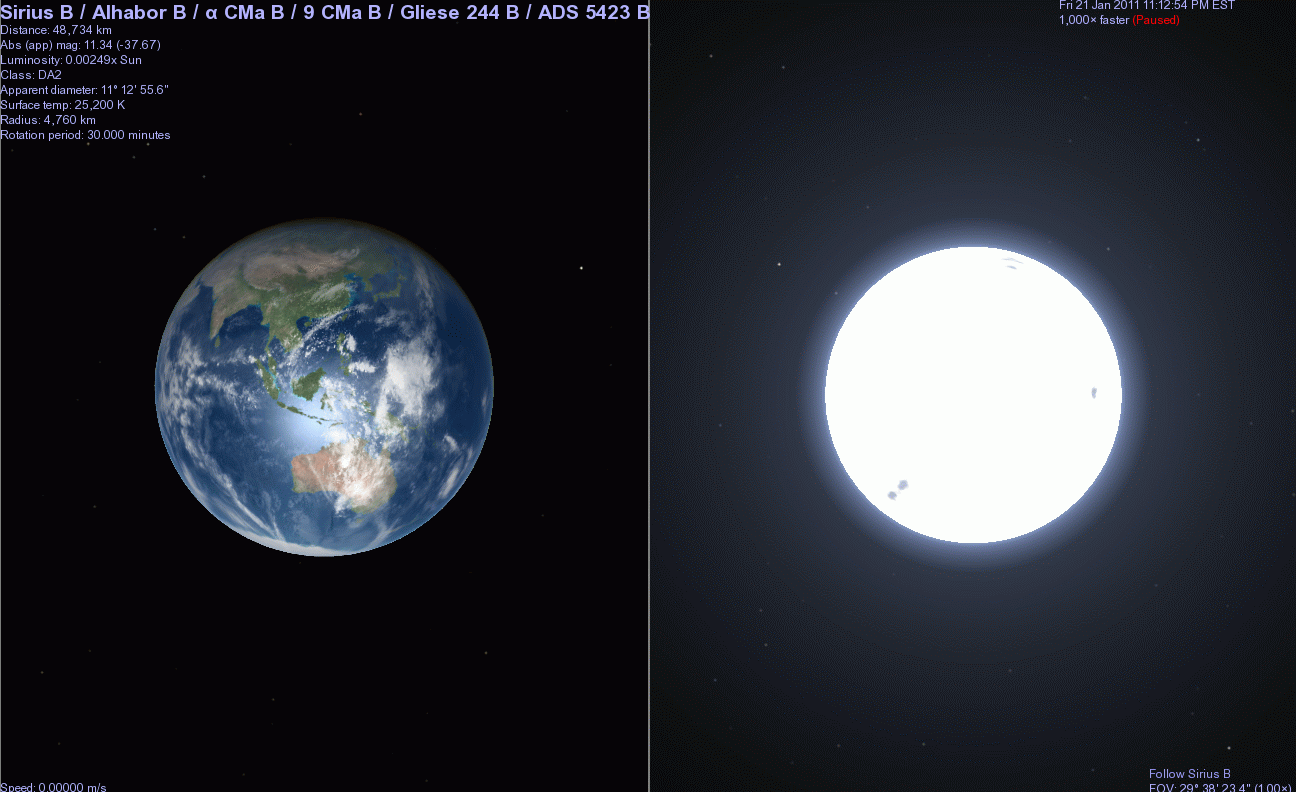
The result is a neutron star, which has the mass of one or two Suns, but the size of the greater metropolitan Rochester region.
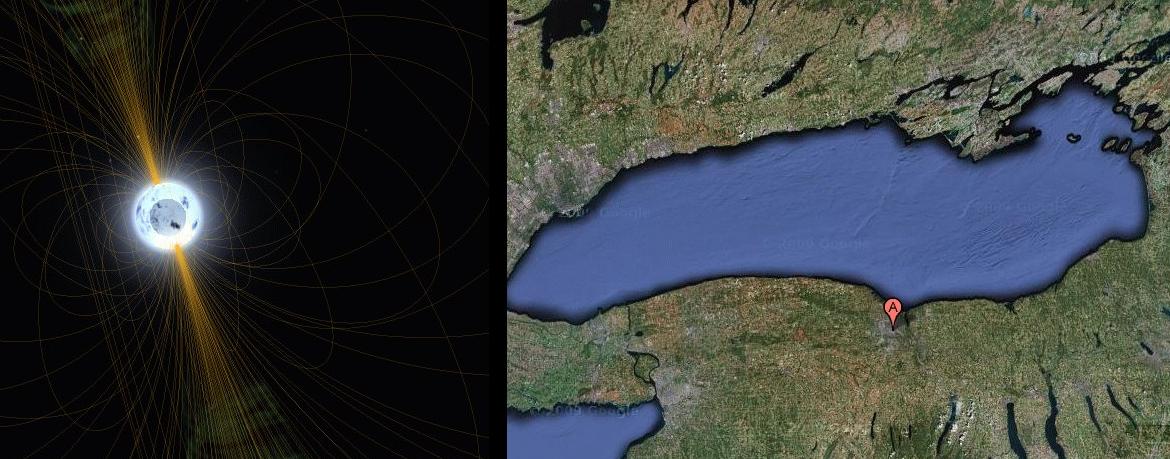
The result is a black hole, which has the mass of one or two Suns, but the size of the greater metropolitan Rochester region.
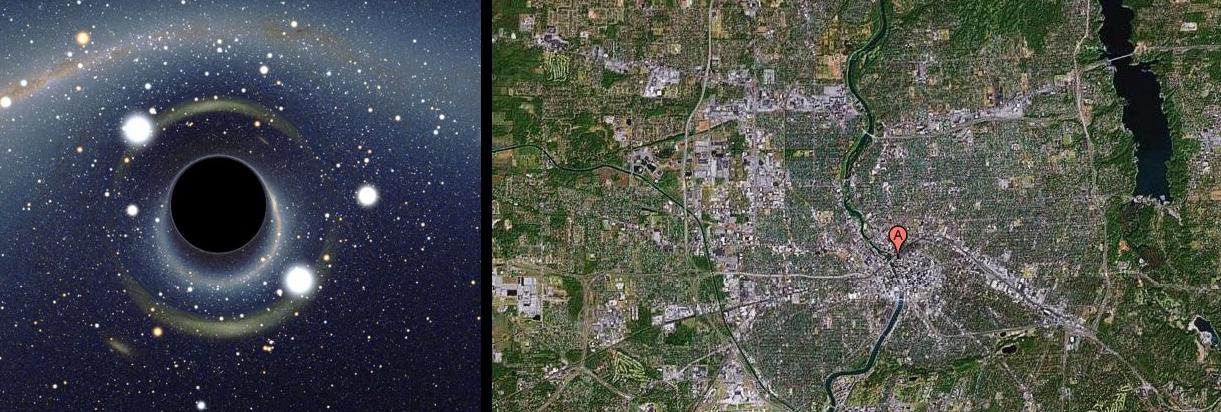
Remember, in an ordinary star, the crucial factor is a careful balance between gas pressure pushing outward, and gravitational force pulling inward. In order to make a star collapse, we can remove the central energy source -- which will reduce the gas pressure. But if we want to make a star explode, we need to increase the outward pressure. The best way to do that is to release a lot of energy, very quickly. If we can produce enough energy, we can increase the gas pressure (and additional sources of pressure, in certain circumstances) enough to exceed the pull of gravity. Result: a big boom.
Let's begin with an "incomplete" explosion, one which doesn't destroy the star. Astronomers call the following process a nova.
We start with a white dwarf star which is in a very particular situation. First, it must have a mass of less than about 1.4 solar masses. Second, it must be part of a binary star system, with a companion which is an ordinary main sequence star. Third, the companion must be at just the right distance that the white dwarf can accrete some of the material from the companion's outermost atmosphere, like this:
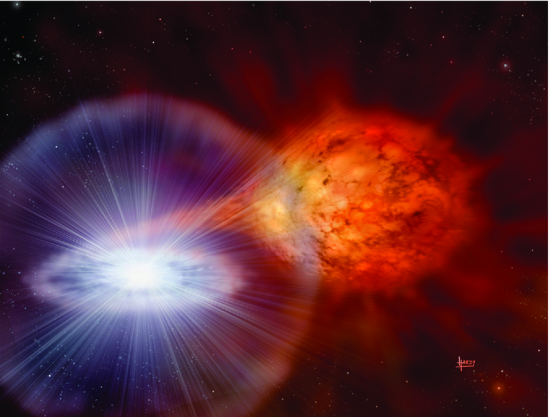
If all the conditions are just right, then the white dwarf will build up an outer shell of hydrogen-rich material over its core, which is mostly carbon and oxygen.
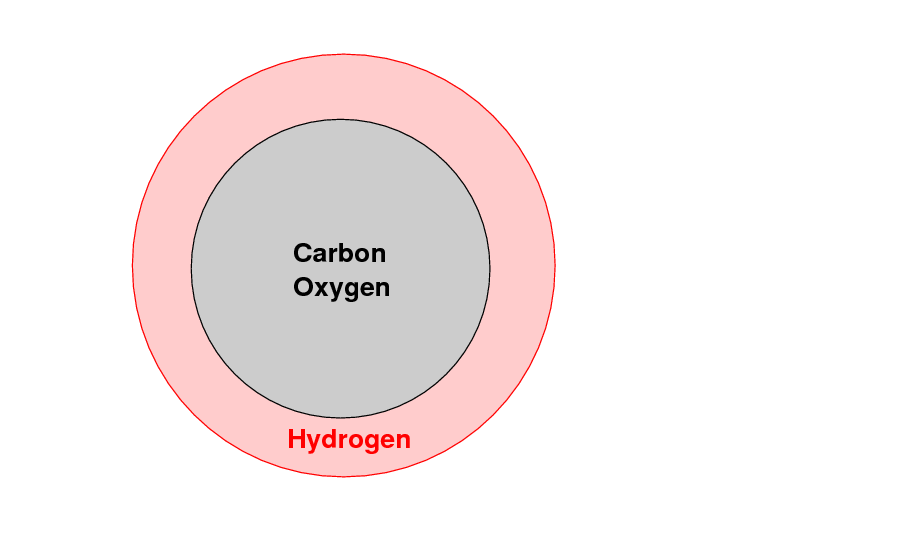
If the hydrogen layer grows deep enough, the weight of its topmost material will push down on the bottom, increasing the density and temperature of the hydrogen there.
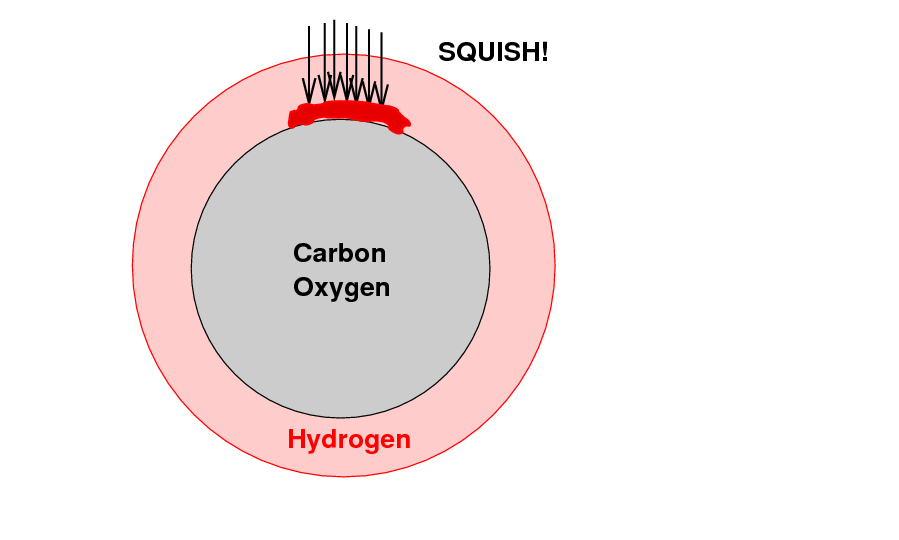
If you press hydrogen atoms together hard enough, they may undergo fusion reactions: the hydrogen turns into helium and emits a huge amount of energy. As soon as one spot starts to fuse, the reaction spreads around the star, and much of the outer hydrogen layer blows itself off in a big explosion.
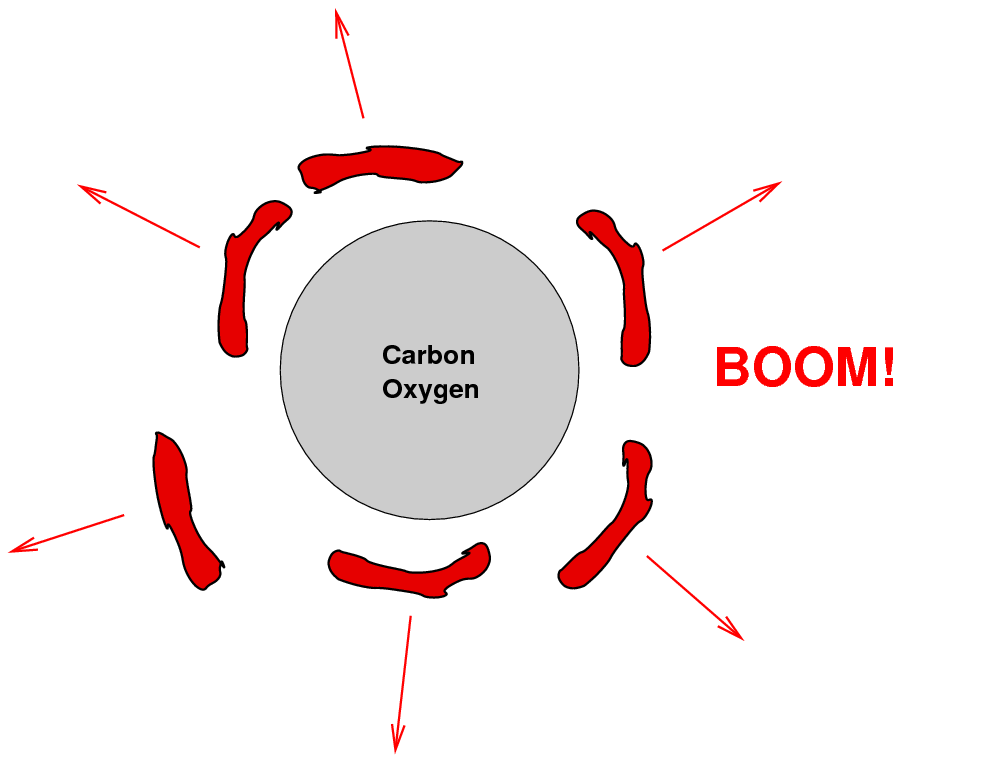
In 1901 astronomers, noticed a nova in the constellation of Perseus, which briefly appeared to be one of the brightest stars in the sky. If we look at it now, we see blobs of gas from that outer layer of hydrogen-rich material:
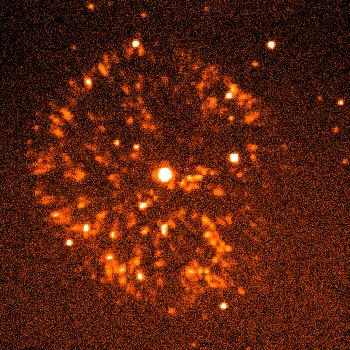
Note that the white dwarf is not completely destroyed. The central core of carbon and oxygen remains, and the star may begin accreting material from its companion again.
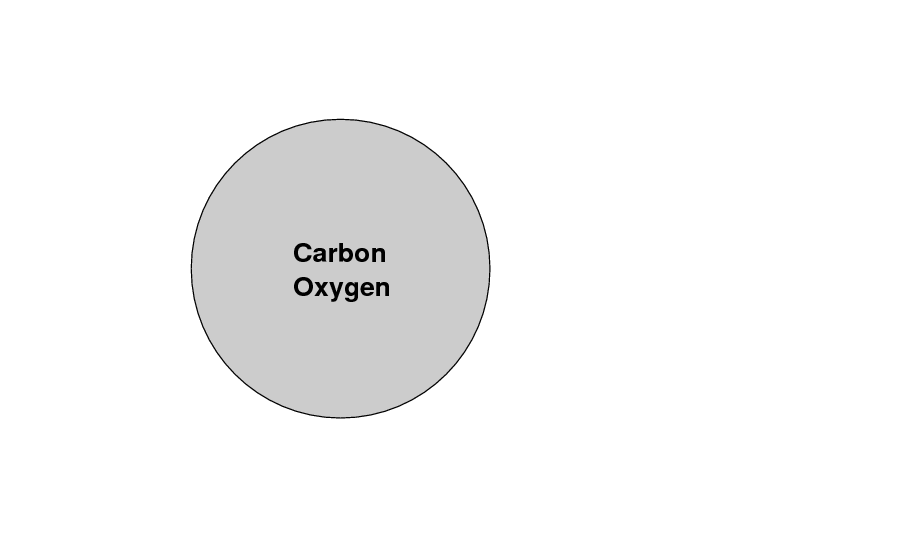
A white dwarf may undergo several, or many, nova explosions during its long lifetime.
What are the extra special conditions?
If the white dwarf accretes enough material to push its mass very close to the Chandrasekhar limit -- about 1.4 solar masses -- then the central temperature will rise high enough to cause carbon nuclei to fuse. Because the interior is degenerate, it doesn't expand as this fusion increases the temperature ... and so more and more carbon fuses, increasing the temperature even further. Eventually, a runaway thermonuclear reaction spreads throughout the entire white dwarf.
During this very rapid fusion, carbon and oxygen nuclei fuse to form nuclei of heavier elements, such as magnesium, silicon, sulfer, and so forth. Fusion reactions which proceed as far as the iron group will continue to produce energy, while those which involve heavier elements don't emit energy; they absorb some energy from the environment when they occur.
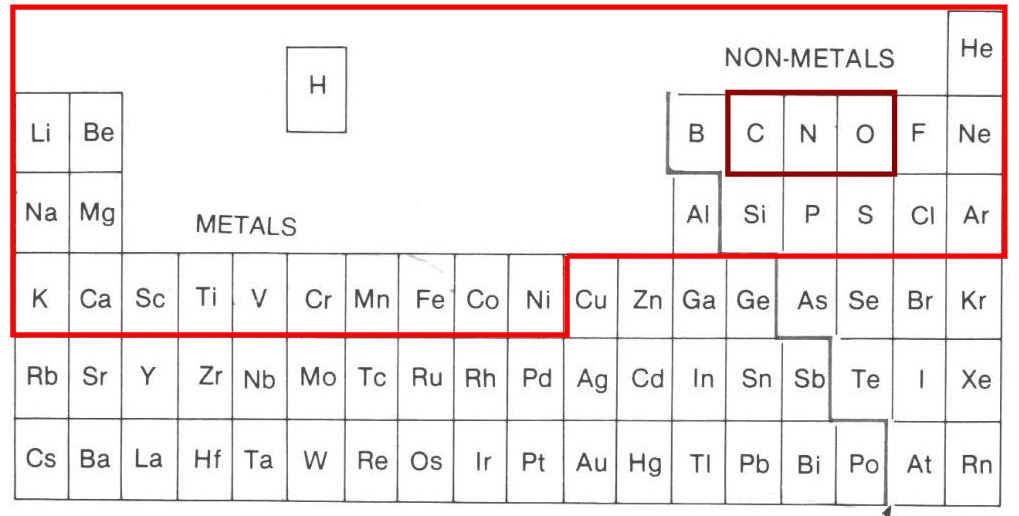
Thanks to SimpleChemConcepts for the table.
The entire undergoes these fusion reactions in just a few seconds, turning what used to be a ball of (mostly) carbon and oxygen into an expanding cloud of (mostly) iron and nickel.
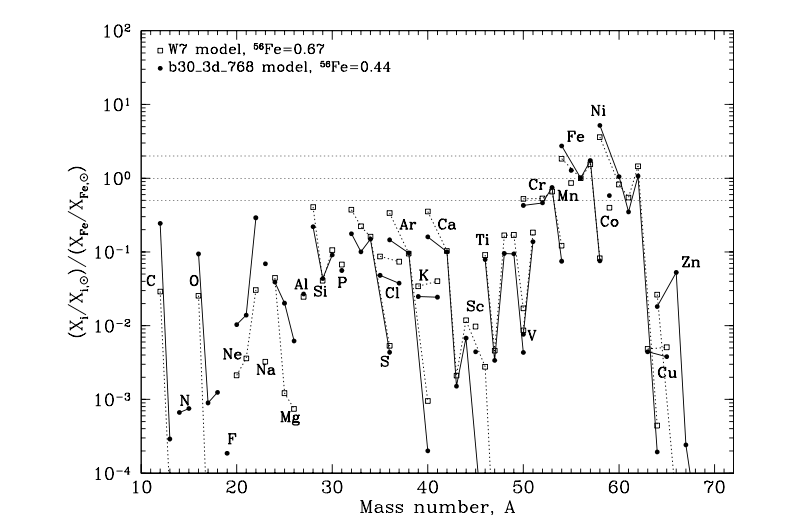
Yield of a SN Ia explosion model, from
Travaglio et al., A&A 425, 1029 (2004)
This scenario is also known as a Type Ia supernova. The runaway nuclear reaction creates so much energy, so quickly, that internal pressure completely overwhelms the gravitational force, blowing the white dwarf apart and leaving its companion a lonely single star. The explosion creates one of the most luminous events in the universe. In 1885, a white dwarf in the Andromeda Galaxy exploded in this fashion and became so bright that it was (barely) possible to see it with the naked eye.
There's another way to produce a sudden burst of energy at the center of a star and cause it to explode, and so another way to create a supernova. Because this situation always involves the collapse of the central core of a massive star, astronomers call these events core-collapse supernovae (there are other names for them, too, such as "Type II" or "Type Ib" or "Type Ic" or "Type IIb", but those refer to less important details). In order to understand the sudden burst of energy, we need to take a look into the interiors of massive stars.
Stars begin their lives as balls of mostly hydrogen (H) gas, with a small fraction of helium (He) and very little else. To a decent approximation, we can say that the entire star, outside and inside, is hydrogen.
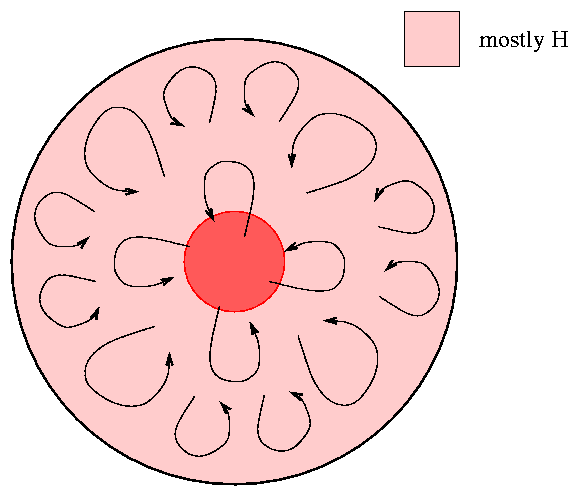
In the center of the star, temperatures and densities are so high that the hydrogen fuses into helium, producing the energy which heats the star and produces the gas pressure needed to resist the pull of gravity.
Over the course of hundreds of thousands of years (for a massive star), the helium produced by fusion builds up in the core.
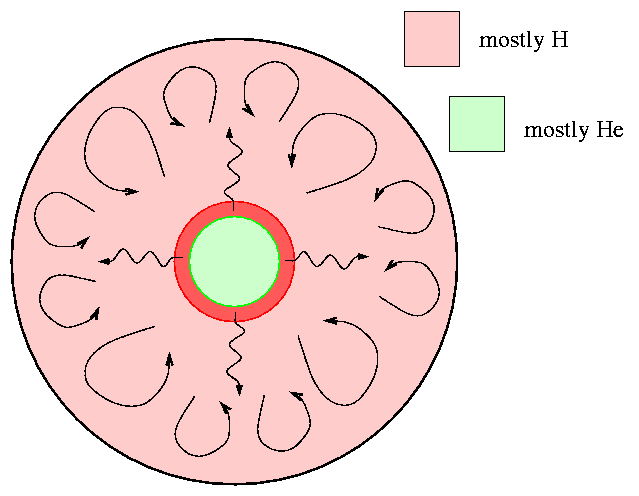
When hydrogen becomes scarce inside the core, ordinary hydrogen-to-helium fusion reactions cannot produce enough energy to resist the pull of gravity. As a result, the core begins to shrink, so that its density and temperature rise. At some point, the temperature becomes high enough that helium begins to fuse into carbon and oxygen; that new reaction halts any further collapse.
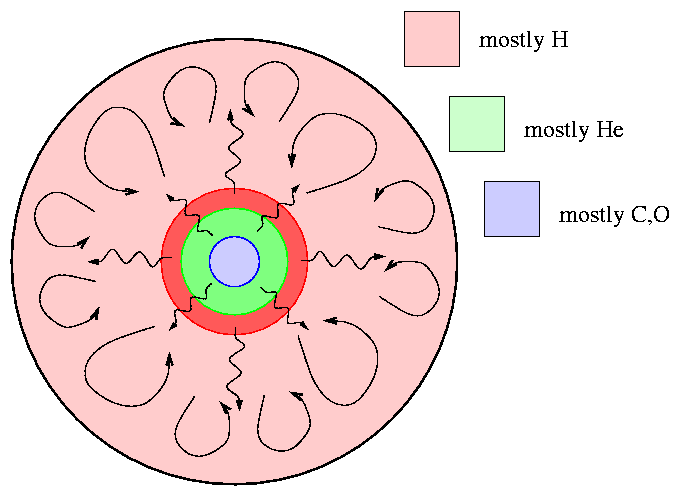
But then the helium in the central region grows scarce, and so the process repeats: heavier elements begin to fuse in the core, creating in turn an "ash" of even heavier elements. Eventually, the star's interior resembles that of an onion, with many layers consisting of different elements. At the very center is a core of iron.
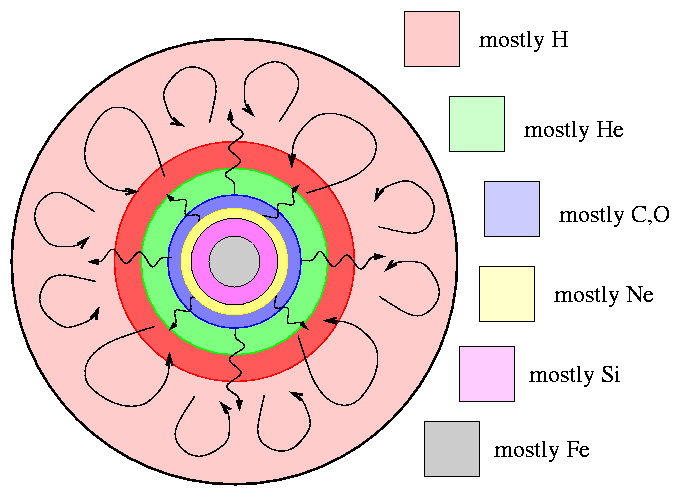
Here's a more quantitative view of the interior of a massive star (25 solar masses, to be specific).
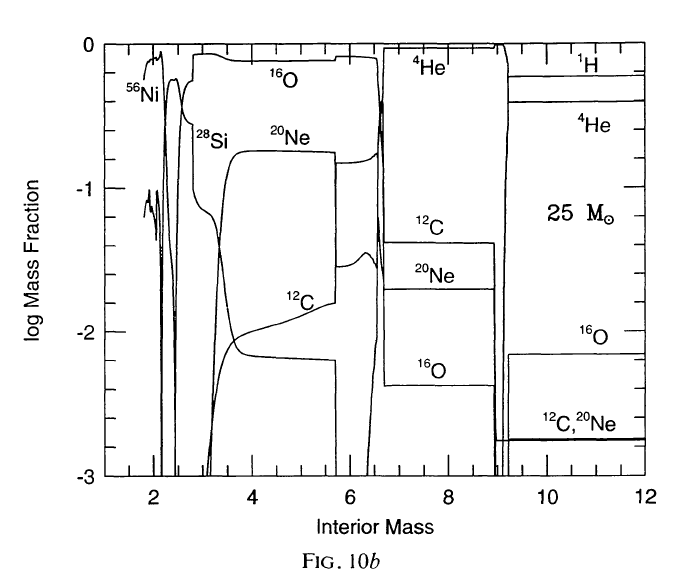
When the silicon in the core runs out and silicon fusion reactions can't produce much energy, once again the core starts to collapse. This time, however, something is radically different. On all the previous occasions, the core material could fuse to produce energy:
Hydrogen --> Helium + energy
Helium --> Carbon, oxygen + energy
Carbon --> Neon + energy
Neon --> Silicon + energy
Silicon --> Iron + energy
But if one fuses iron nuclei together, one does not produce energy; instead, one absorbs it from the environment. When the iron core starts to shrink, due to the everpresent force of gravity, fusion cannot produce the energy required to heat it up and resist the shrinking. The core collapses (hence the name).
Instead, a series of rather complex events take place in very rapid succession as the iron-rich core collapses. The result will turn out to be a quick transfer of enormous amounts of energy to the outer portion of the star's material ... while the innermost core continues to collapse.
The result separates the star into two portions: a central core of pure neutrons, about the size of a city, and the gaseous outer layers which are blown off by the shock wave and neutrino heating.
You might enjoy a more realistic and detailed simulation -- the one below can be found at the Type II supernova visualizations website of the Rechenzentrum Garching IPP. Thanks to M. Rampp for the movie. It shows just the very central portion of the core as it collapses; watch the shock wave form and try to burst its way outward as material continues to fall onto the core.
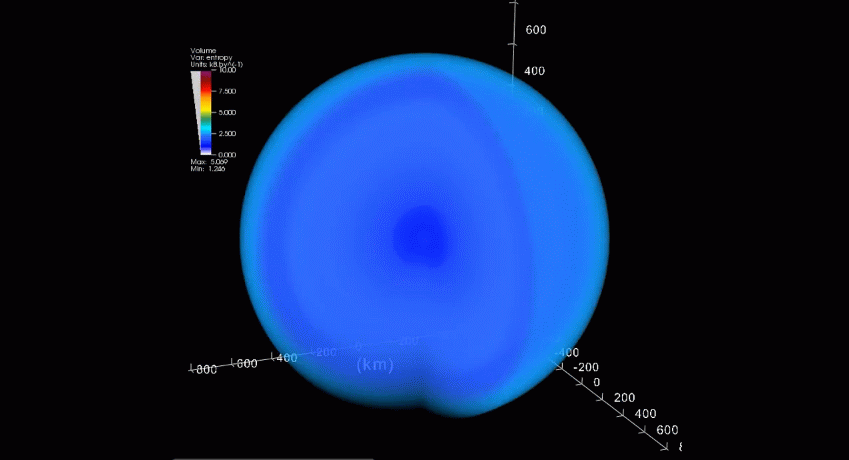
The shock wave forces its way through the outer layers of the star, heating them up to millions of degrees and pushing them outward violently. The outer layers explode, radiating energy like crazy as they fly into space at speeds of over 7000 km/s.
Meanwhile, what happens to the core? There are two possibilities. If only a small fraction of the outer layers manages to fall onto the core, its mass will remain small enough that neutron degeneracy pressure can successfully resist the pull of gravity. In this case, a tiny neutron star remains at the center of the expanding cloud of gas. For example, the explosion which created the Crab Nebula left a neutron star near its center.
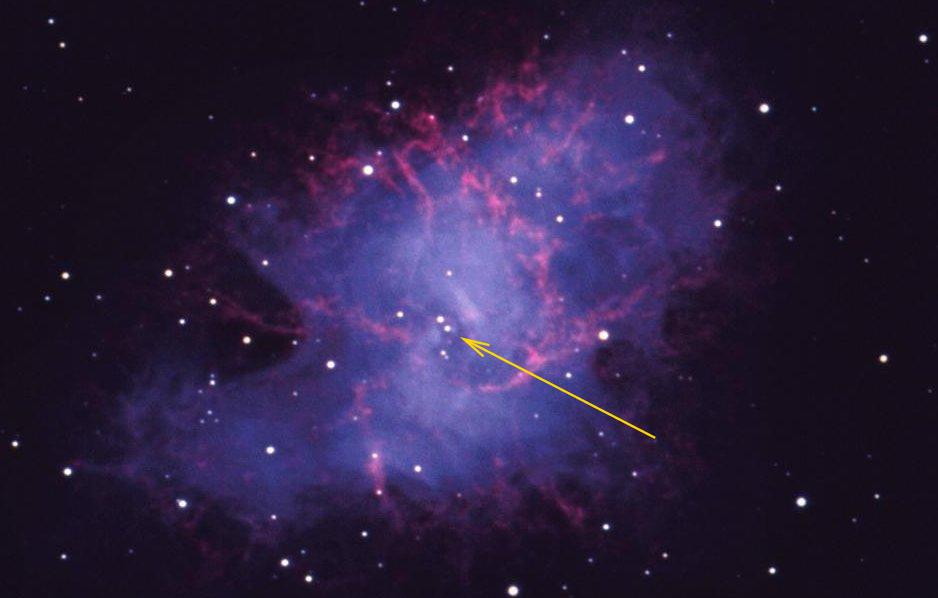
On the other hand, if enough extra material falls onto the core to increase its mass to more than about 2.5 solar masses, the neutron degeneracy pressure is insufficient to resist the pull of gravity. The core will collapse, growing smaller and smaller and smaller, forever, as far as we can tell. It will become a black hole. At a radius of just a few kilometers from the center of this object, the gravitational force is so strong that even light cannot escape. We call that critical radius the "event horizon" of the black hole.
In 1987, a massive star in the Large Magellanic Cloud, one of the Milky Way's nearest neighbors, turned into a core-collapse supernova. Did the core turn into a neutron star or a black hole? We're not sure: the best pictures we can take show a small amount of radiation still coming from the central area of the explosion, but that might be due to some of the hot gases still glowing. It will take decades or more for the gases to cool off and fade enough for us to see -- or not see -- the neutron star which might remain.
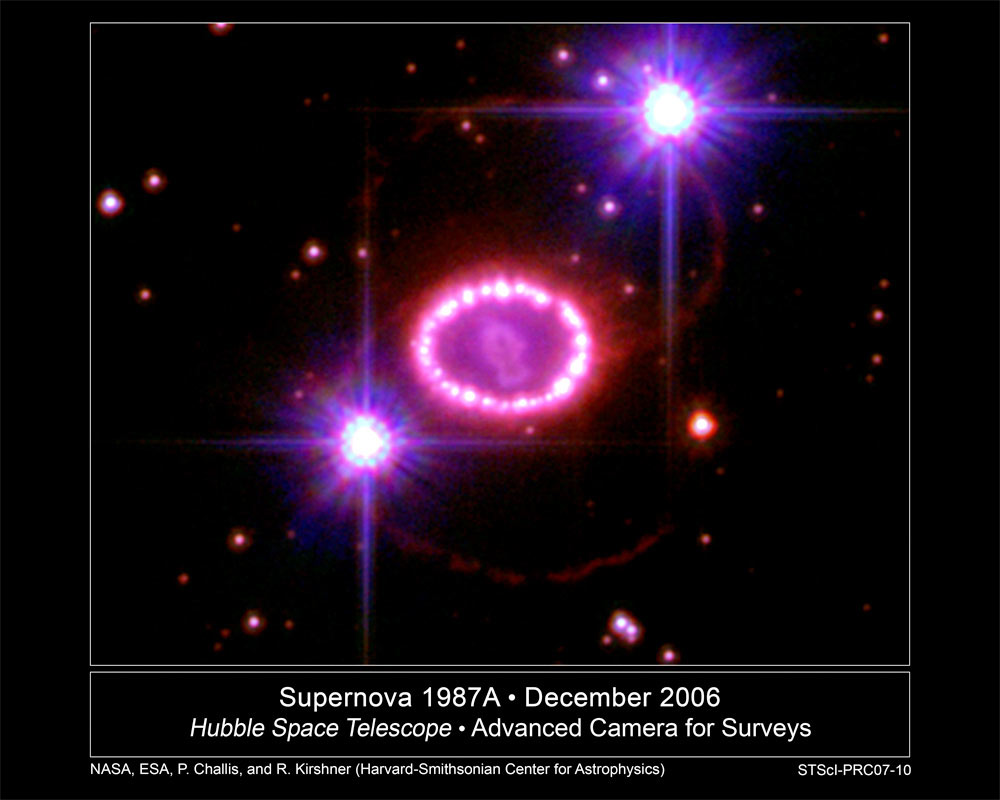
 Copyright © Michael Richmond.
This work is licensed under a Creative Commons License.
Copyright © Michael Richmond.
This work is licensed under a Creative Commons License.